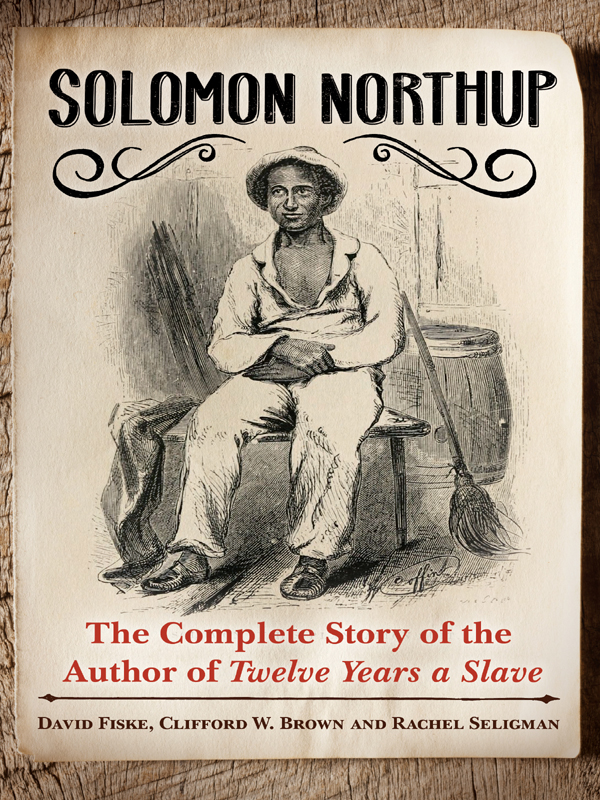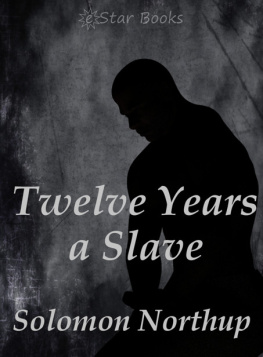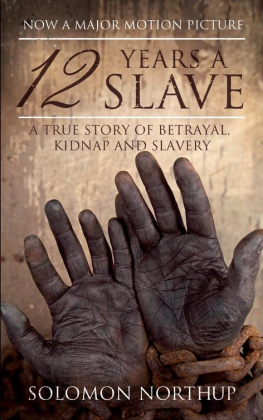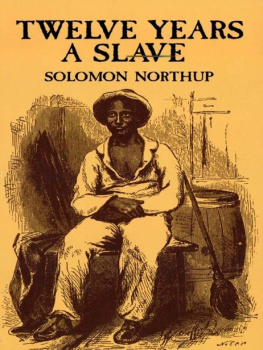
Solomon Northup
Solomon Northup
The Complete Story of the Author of Twelve Years a Slave
David Fiske, Clifford W. Brown, and Rachel Seligman

AN IMPRINT OF ABC-CLIO, LLC
Santa Barbara, California Denver, Colorado Oxford, England
Copyright 2013 by David Fiske, Clifford W. Brown, and Rachel Seligman
All rights reserved. No part of this publication may be reproduced, stored in a retrieval system, or transmitted, in any form or by any means, electronic, mechanical, photocopying, recording, or otherwise, except for the inclusion of brief quotations in a review, without prior permission in writing from the publisher.
Library of Congress Cataloging-in-Publication Data
Fiske, David (David A.), 1954
Solomon Northup : the complete story of the author of Twelve years a slave / David Fiske, Clifford W. Brown, and Rachel Seligman.
pages cm
Includes bibliographical references and index.
ISBN 978-1-4408-2974-1 (hardcopy : alk. paper) ISBN 978-1-4408-2975-8 (ebook) 1. Northup, Solomon, 1808 2. SlavesUnited StatesBiography. 3. African AmericansBiography. 4. Plantation lifeLouisianaHistory19th century. 5. SlaveryLouisianaHistory19th century. 6. Northup family. 7. Hampton family. 8. Stanton family. 9. Slaves writings, American. 10. Northup, Solomon, 1808 Twelve years a slave. I. Brown, Clifford W. (Clifford Waters), 1942 II. Seligman, Rachel. III. Title.
E444.N87F57 2013
306.3'62092dc23
[B] 2013011536
ISBN: 978-1-4408-2974-1
EISBN: 978-1-4408-2975-8
17 16 15 14 13 1 2 3 4 5
This book is also available on the World Wide Web as an eBook.
Visit www.abc-clio.com for details.
Praeger
An Imprint of ABC-CLIO, LLC
ABC-CLIO, LLC
130 Cremona Drive, P.O. Box 1911
Santa Barbara, California 93116-1911
This book is printed on acid-free paper 
Manufactured in the United States of America
This book is dedicated to the many African American victims of kidnapping who, unlike Northup, were never rescued and lived out their remaining days as slaves. May their stories some day be told.
Contents
Maps and Illustrations
MAPS
ILLUSTRATIONS
(Photo essay follows page 110)
Foreword
I have been aware of my great-great grandfathers story since high school. My mother, Victoria Northup Linzy Dunham, Alonzo Northups granddaughter, gave me and my brothers and sisters copies of Twelve Years a Slave (facsimiled from the first edition) at an early agebut, like many young people I did not pay a lot of attention to family history. Later on, I regrettably lost the book. With all the responsibilities of raising a family, as well as holding a responsible position outside the home, I let Solomons story fade into the background. In 1999, our local newspaper carried a story about Union Colleges Solomon Northup exhibit. I was curious, contacted the College, and as a result, was invited to participate in the final program where I was asked to read a moving passage from Solomons book. When Saratoga Springs started Solomon Northup Day shortly thereafter, my family attended in force, including my 90-plus year-old mother then living in California. These annual events enabled our family to reconnect to its past and appreciate the importance of the Solomon Northup story. I am very pleased that there is now a renewed interest in my ancestor, that the Fiske, Brown, and Seligman biography of him is being published, and that even Hollywood will present its version. As a result, our whole family will have an enhanced understanding of our ancestors story and its importanceand so will lots of other Americans.
It is a story worth remembering. There are many lessons in Grandpa Northups book, but to me the most important one is about persistence and determination in the face of extraordinary adversity. His life was horribly interrupted at the age of 33, but with remarkable persistence he survived the ordeal and finally made it back to his family. A literate person, he produced a bestseller and shared his story with audiences throughout the country. It also appears that he worked on the underground railroad to help others who had experienced some of the ordeals with which he was familiar. His courage and perseverance should be an inspiration to all humans who face lifes obstacles and tragedies. We are all proud of him and Anne, and hope that others will benefit from knowing his story.
Carol Linzy Adams Sally
Great-great granddaughter of Solomon Northup
Preface
The genesis of this book can be traced back about 15 years, beginning with the separate moments when each of the authors was introduced to the remarkable saga of Solomon Northup. For David Fiske, it was a visit to the Old Fort House Museum in Fort Edward, New York, in the 1990s. The museum is located in a house that Northup and his wife Anne once resided in, and features a permanent exhibit dedicated to his story. This visit sparked a passionate interest in Northup that has led to years of research into the unknown aspects of his life. For Rachel Seligman, it was a friends suggestion that Twelve Years a Slave was essential reading for anyone wanting greater knowledge of local history. That encounter with the story engendered a large-scale exhibition project at the Mandeville Gallery at Union College in 1999 (where Seligman was the director/curator). Seligman, in turn, brought the story to Clifford Brown, professor of political science and then chair of the Mandeville Gallery Advisory Committee. Throughout the creation of the exhibition, and ever since, Brown has continued to be a source of research and a clearinghouse for information on Northup. For all three authors, Northups storythat of a free black man lured away from his home in Saratoga Springs, kidnapped, enslaved for 12 years in rural Louisiana before being rescued, and then returned to his family in upstate New Yorkwas so compelling that it continues to exert an unflagging hold over them.
Northup tells his own story in Twelve Years a Slave, a richly detailed, suspenseful narrative, and a seemingly impossible saga that nevertheless rings with an unwavering authenticity. He was an educated man with a lively interest in the ways of the world, and was able to sustain his curiosity and engagement with life despite his horrifying plight. This is evident in every page of his narrative, with its extensive descriptions of the people, places, and activities with which he was engaged. Because he remained a keen observer throughout his ordeal, his compelling saga reveals to us myriad details of the ordinary routines of daily life on Louisiana plantations in the 1840s and 1850s, as well as vivid descriptions of the life of a slave experiencing the dictates of harsh, arbitrary, and brutal masters.
Despite his situationone that must have seemed an inescapable nightmareNorthup was able to maintain a degree of hope for his future. How was this possible? Would any of us today be able to do so? What explains his ability to stay engaged and interested in the workings of the plantation and in the lives of his fellow slaves? What accounts for his continued hope in the face of the seeming hopelessness of his situation? Northups resourcefulness and inner strength provide valuable lessons.
Northup was eventually freed. Although it was sadly commonplace for free black citizens to be kidnapped into slavery, it was an extremely rare and remarkable occurrence for anyone to be rescued, as Northup was. With his freedom came opportunities to share his story with the world, and not surprisingly, he seized these opportunities, not only through the written narrative, but also through a series of public tours, theatrical reenactments, and other activities. His aim was to shed light and spread awareness in the North about the peculiar institution of slavery. He became an active abolitionist, helping others escape slavery. His book (published not long after Harriet Beecher Stowes wildly popular
Next page











